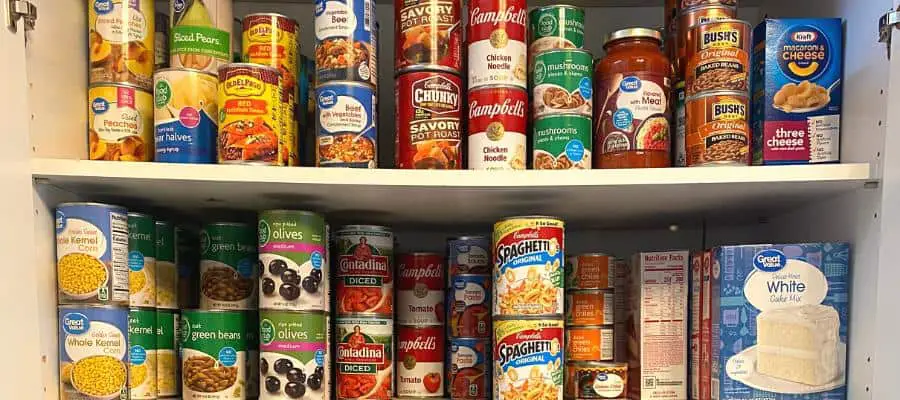Being prepared and building a stockpile of food can seem overwhelming and expensive. However, did you know you can build a stockpile of food storage for as little as $5 a week? That’s the same cost as one trip to Starbucks, snacks from the gas station, or one impulse purchase at the grocery store.
Prepping and stockpiling food can be cheap and easy if it is important to you and you make it a priority. Use our $5 a week buying guide below to help you start stockpiling food so you’ll be prepared to feed your family no matter what happens in life.
Jump down the page to see our 5 Dollars a Week Buying Guide
Where to find the cheapest foods to stockpile?
To help take pressure off of your budget find the cheapest grocery stores, the best places to buy bulk food online, and even find deals at an Amish bulk food store near you.
Why Should I Use My Budget to Stockpile of Food?
You never know when disasters, pandemics, supply chain issues, shortages, or other unforeseen events will transpire and leave grocery stores with empty shelves. There are many reasons you want a stockpile of food including:
- Grocery stores shut down
- Loss of job that limits funds
- Trucking companies unable to make deliveries
- Grocery store shelves are empty
- Grocery prices rising causing foods and brands to be unaffordable
- Natural disasters that temporarily limit deliveries
- Supply chain issues
- Food shortages (see how to prepare for food shortages)
All of these events happening can cause a great amount of stress if your pantry shelves are empty. If you no longer have access to food or can no longer afford food, having a stockpile is a great piece of mind and could be life-saving.
6 Tips for Stockpiling Food on a Budget
When done right, having a stockpile of food can be done affordably and not wastefully. Here are 6 tips to help when building your stockpile.
1. Stock things that you know you and your family will eat
When you are building your stockpile make sure the foods you are storing are food that you and your family will eat. Storing 50 pounds of lima beans that you won’t eat even in an emergency does no good and uses up valuable space and money that can be used for other things (see our guide to building a 3-month food supply).
2. Stock things that have a long shelf life
Storing foods that have a long shelf life is a great way to have a lasting stockpile. Foods such as flour, sugar, rice, and beans have a very long shelf life. But canned foods such as soups, vegetables, fruits, and more have up to a 5-year shelf life. These are also considered longer shelf-life foods and are great to buy when stockpiling foods.
3. Buy double when buying ingredients for weekly meals
My favorite way to stockpile on a budget is to buy one for now and 2 for later when purchasing food for my weekly meals. When I am not able to shop case lot sales for deals it is easy to purchase one or two extra items to stockpile to make the same meal again at a later date.
4. Have proper containers for food storage
When stockpiling foods it is important to make sure that you are storing foods in the proper containers to help them last. Foods such as canned goods are fine to store on their own. foods such as rice, flour, sugar, and beans should be moved from their original packaging and put in either 5-gallon buckets with oxygen absorbers or sealed in mylar bags with oxygen absorbers to extend the shelf life even longer.
Important things to consider when looking for containers to store your food storage include:
- How to properly use oxygen absorbers in food storage
- Best airtight pantry containers
- Is it worth using a vacuum sealer
- Which plastics are safe to use for food storage
5. Rotate foods
When you stockpile food it is important that you are constantly rotating the food so that it doesn’t expire. Stockpiling food is not just getting the food and holding on to it. The oldest foods should be used first. When storing food the oldest food should come to the front and the newest food should go in the back. These can rotators are a great tool to help not waste food.
6. Buy store or generic brand foods
When you are stockpiling on a budget buying name-brand food will use up that money really quickly. Brands such as Kroger, Great Value, Food Club, Signature Select, Kirkland, Member’s Mark, and many others are great ways to get the most for your money when building a stockpile.
When on a budget it’s good to know the cheapest brands and find the cheapest grocery stores to shop at to help save money. We also like to take advantage of deals at Amish bulk food stores (Find an Amish store near you).

5 Dollars a Week Buying Guide to Building a Food Stockpile
When planning what to spend your $5 on each week where you live and the current price of groceries will determine what you buy. This may mean that you buy a 10-pound bag of flour instead of a 25-pound bag of flour. Or Multiple smaller bags of sugar instead of the largest bag of sugar. Having a smaller amount on hand is better than not having anything in your pantry.
Week 1 – Flour
Week 2 – Sugar
Week 3 – Salt
Week 4 – Yeast
Week 5 – Baking Soda
Week 6 – Baking Powder
Week 7 – Brown Sugar
Week 8 – Pasta
Week 9 – Beans
Week 10 – Rice
Week 11 – Powdered Milk
Week 12 – Oats
Week 13 – Honey
Week 14 – Pasta Sauce
Week 15 – Pancake Mix
Week 16 – Cocoa Powder
Week 17 – Cornmeal
Week 18 – Canned Soup or other canned items
Week 19 – Vegetable Oil
Week 20 – Shortening
Week 21 – Peanut Butter
Week 22 – Jam
Week 23 – Canned Vegetables
Week 24 – Canned Fruit
Week 25 – Whole Wheat Berries (Stores like Winco offer purchase by the pound)
Week 26 – Pasta Sauce
Week 27 – Canned Meat (tuna, chicken)
Week 28 – Mac and Cheese Boxes
Week 29 – Flour
Week 30 – Sugar
Week 31 – Canned Vegetables
Week 32 – Canned Fruits
Week 33 – Spices
Week 34 – Brown Sugar
Week 35 – Rice
Week 36 – Honey
Week 37 – Powdered Milk
Week 38 – Oats
Week 39 – Pancake Mix
Week 40 – Canned Soup or other canned items
Week 41 – Vegetable Oil
Week 42 – Peanut Butter
Week 43 – Whole Wheat Berries (Stores like Winco offer purchase by the pound)
Week 44 – Canned Meat (tuna, chicken)
Week 45 – Jam
Week 46 – Sauce (BBQ, Worcestershire, soy sauce)
Week 47 – Pasta
Week 48 – Beans
Week 49 – Canned Vegetables
Week 50 – Canned Soup or other canned items
Week 51 – Rice
Week 52 – Flour
Total: $260 per year
Monthly Cost: $21.67
Food storage items that may cost more than $5 a week but may be worth considering include:
- Bulk wheat berries (see hard red wheat or soft white wheat on Amazon)
- Freeze-dried fruits and vegetables (see options on Amazon)
- Freeze-dried meat (see options on Amazon)
- Freeze-dried meals (see options on Amazon)
- Bulk food items
- Emergency food buckets (see options on Amazon)
Non-food Items to Also Budget For and Stockpile
Once you get started, and you want to be more serious about building a stockpile of more than just food, here is a simple way to add those extras necessities such as
- toilet paper
- paper towels
- soaps
- shampoo and conditioner
- cleaning supplies
- toothpaste
- Over-the-counter medicine’s
- Food preservation tools (dehydrator, freeze dryer, vacuum sealer, oxygen absorbers, wheat grinder, etc.)
Once a month plan to spend $20 on other necessities in addition to the weekly $5 on food storage. For $500 a year you can have a solid stockpile of all the necessities you and your family could need. To purchase bigger items save the extra $20 per month till you have to total amount. Physically setting that money aside if you need to.
Weekly – $5 on food stockpile
Once a month – extra $20 on items listed above
Total: per year $500


